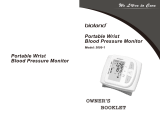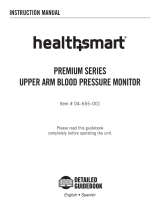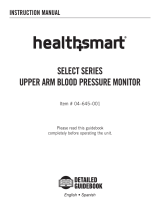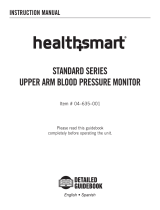Page is loading ...

Wrist Blood Pressure Monitor
Instruction Manual
Table of contents
1. Introduction
1.1. Features of the Wrist Blood Pressure Monitor
1.2. Inflation Mode Technology
1.3. Important information about self-measurement
2. Important information about blood pressure and its measurement
2.1. How does high/low blood pressure arise?
2.2. Which values are normal?
2.3. What can be done if regular high/low values are obtained?
3. Components of your blood pressure monitor
4. Using your blood pressure monitor for the first time
4.1. Inserting the batteries
4.2. Setting the date and time
5. Taking a blood pressure measurement
5.1. Before the measurement
5.2. Common sources of error
5.3. Fitting the cuff
5.4. Measuring procedure
5.5. Discontinuing a measurement
5.6. Irregular heartbeat detection
5.7. Hypertension risk indicator
5.8. Memory – storage and recall of the last 90 measurements
5.9. Memory – cancellation of all measurements
6. Battery charge indicator
1

2
7. Error messages/troubleshooting
8. Care and maintenance
9. Warranty
10. Certifications
11. Technical specifications
12. How to contact us

1. Introduction
1.1. Features of the Wrist Blood Pressure Monitor
This blood pressure monitor (with irregular heartbeat detection) is a fully
automatic, digital blood pressure measuring device for use on the wrist.
This monitor enables very fast and reliable measurement of your systolic
and diastolic blood pressure as well as pulse by way of the oscillometric
method of measuring. This device offers a very high and clinically tested
measurement accuracy and is designed for maximum user-friendliness.
Before using it, please read through this instruction manual carefully and
keep it in a safe place. For further questions on the subject of blood pres-
sure and its measurement, please contact your doctor.
1.2. Inflation Mode Technology
Please note that this device employs our new “Inflation Mode Technology.”
This means your blood pressure is measured while the wrist cuff is inflat-
ing, rather than first inflating to a peak pressure and then measuring dur-
ing a slow deflation process. This unique technology provides a faster,
more comfortable blood pressure reading for you.
If you have any questions about your blood pressure reading or monitor,
please call us at 1-855-776-0662.
Attention!
1.3. Important information about self-measurement
• Self-measurement means control, not diagnosis or treatment. Unusual
values must always be discussed with your doctor. Under no circum-
stances should you alter the dosages of any drugs prescribed by your
doctor.
• The pulse display is not suitable for checking the frequency of heart
pacemakers.
• In cases of irregular heartbeat, measurements made with this instru-
ment should only be evaluated after consultation with your doctor.
3

Electromagnetic interference:
The device contains sensitive electronic components. Avoid strong electri-
cal or electromagnetic fields in the direct vicinity of the device (e.g.,
mobile telephones, microwave ovens). These can lead to temporary
impairment of the measuring accuracy.
2. Important information about blood pressure and its measurement
2.1. How does high/low blood pressure arise?
Your level of blood pressure is determined in the circulatory center of the
brain and adjusts to a variety of situations through feedback from the ner-
vous system. To adjust blood pressure, the strength and frequency of the
heart (pulse), as well as the width of circulatory blood vessels is altered.
Blood vessel width is affected by way of fine muscles in the blood vessel
walls. Your level of arterial blood pressure changes periodically during
heart activity. During the "blood ejection" (Systole), the value is highest
(systolic blood pressure value). At the end of the heart’s "rest period"
(Diastole), pressure is lowest (diastolic blood pressure value). Your blood
pressure values must lie within certain normal ranges in order to prevent
particular diseases.
2.2. Which values are normal?
Blood pressure is very high if your diastolic pressure is above 100 mmHg
and/or your systolic blood pressure is over 160 mmHg, while at rest. In
this case, please consult your physician immediately. Long-term values at
this level endanger your health due to continual damage to the blood ves-
sels in your body.
If your systolic blood pressure values are between 140 mmHg and 159
mmHg and/or the diastolic blood pressure values are between 90 mmHg
and 99 mmHg, consult your physician. Regular self-checks are necessary.
If you have blood pressure values that are too low (i.e., systolic values
under 105 mmHg and/or diastolic values under 60 mmHg), consult your
physician.
4

Even with normal blood pressure values, a regular self-check with your
blood pressure monitor is recommended. You can detect possible changes
in your values early and react appropriately.
If you are undergoing medical treatment to control your blood pressure,
keep a record of values along with time of day and date.
Show these values to your physician. Never use the results of your
measurements
to independently alter the drug doses prescribed by
your physician.
Which values are normal?
The following standards for assessing high blood pressure (in adults) have
been established by the U.S. National Institutes of Health JNC7, 2003.
+ Further information
• If your values are mostly normal under resting conditions but excep-
tionally high under conditions of physical or psychological stress, it is
possible that you are suffering from so-called "labile hypertension."
Consult your physician.
• Correctly measured diastolic blood pressure values above 120 mmHg
require immediate medical treatment.
This device is not intended for use on children 12 years of age or
younger.
5
Category Systolic Diastolic
(mmHg) (mmHg)
Normal Self-Check <120 and <80
Pre-Hypertension 120 - 139 or 80 - 89
Stage 1 Hypertension 140 - 159 or 90 - 99
Stage 2 Hypertension
≥160 or ≥100

2.3. What can be done if regular high/low values are obtained?
a) Consult your physician.
b) Increased blood pressure values (various forms of hypertension) are
associated with considerable health risks over time. Arterial blood ves-
sels in your body are endangered due to constrictions caused by
deposits in the vessel walls (arteriosclerosis). A deficient supply of
blood to important organs (heart, brain, muscles) can result. Further-
more, the heart will become structurally damaged with increased
blood pressure values.
c) There are many different causes of high blood pressure. We differenti-
ate between the common primary (essential) hypertension and sec-
ondary hypertension. Secondary hypertension can be ascribed to spe-
cific organ malfunctions. Please consult your physician for information
about the possible origins of your own increased blood pressure values.
d) There are measures you can take to reduce and even prevent high
blood pressure. These measures must be permanent lifestyle changes.
1) Eating habits
• Strive for a normal weight corresponding to your age. See your doctor
for your ideal weight.
• Avoid excessive consumption of common salt.
• Avoid fatty foods.
2) Previous illnesses
•
Follow consistently any medical instructions for treating illness such as:
• Diabetes (diabetes mellitus)
• Fat metabolism disorder
• Gout
3) Habits
• Give up smoking completely.
6

• Drink only moderate amounts of alcohol.
• Restrict your caffeine consumption (e.g., coffee).
4) Physical constitution
• After a preliminary medical examination, do regular exercise.
• Choose sports which require stamina and avoid those which require
strength.
• Avoid reaching the limit of your performance.
• With previous illnesses and/or an age of over 40 years, please consult
your doctor before beginning your exercise routine. He will advise you
regarding the type and extent of exercise that is appropriate for you.
3. Components of your blood pressure monitor
The illustration shows your blood pressure monitor, consisting of:
Fits wrist size 13.5-19.5 cm (5.3"-7.7")
M
T
Universal Size
Wrist Cuff
Battery Cover
Time/Date Button
Memory Recall
Hypertension
Risk Indicator
ON/OFF/START
Button
7

8
4. Using your blood pressure monitor for the first time
4.1. Inserting the batteries
After you have unpacked your device, insert the batteries. The battery
compartment is located on the underside of the device.
a) Remove the battery cover.
b) Insert the batteries (2 x size AAA 1.5 V), following the indicated polarity.
c) If the battery warning appears in the display, the batteries are
discharged and must be replaced with new ones.
Attention!
• Please use «AAA» Long-Life or Alkaline 1.5 V batteries.
4.2. Setting the date and time
1. After the new batteries are activated, the year number flashes in the
display. You can advance the year by pressing
the "M" button. To confirm and then set the
month, press the time button.
2. You can now set the month using the "M" but-
ton. To confirm and then set the day, press the
time button.
3. Please follow the instructions above to set the
day, hour and minutes.
4. Once you have set the last minute and pressed
the time button, the date and time are set and
the time is displayed.
5. If you want to change the date and time, press
and hold the time button down for approx. 3
seconds until the year starts to flash, then
release and press the time button again. The
year will now be flashing and you can enter the
new values as described above.
TIME PM
Memory
Button
Time/Date
Button

9
5. Taking a blood pressure measurement
Please note: You should always be seated before and during the
measurement.
5.1. Before the measurement:
• Avoid eating, smoking as well as all forms of exertion directly before
your measurement. These factors influence the measurement result.
Relax by sitting in an armchair in a quiet atmosphere for about ten
minutes before your measurement.
• Always measure on the same wrist (normally left).
• Compare readings at the same time of day, since your blood pressure
changes during the course of the day.
5.2. Common sources of error
Note:
Comparable blood pressure measurements always require the
same conditions. These are normally always quiet conditions.
• All efforts to support the arm can increase blood pressure. Make sure
you are in a comfortable, relaxed position and do not flex any of the
muscles in the measurement arm during the measurement. Use a
cushion for support if necessary.
• If the wrist artery lies considerably lower (higher) than the heart, an
erroneously higher (lower) blood pressure will be measured. (Each 15
cm/6"
difference in height results in a measurement error of 10 mmHg.)
• A loose cuff causes false measurement values.
• With repeated measurements, blood can accumulate in the respective
arm, which can lead to false results. Correctly executed blood pres-
sure measurements should therefore first be repeated after a 1
minute pause or after the arm has been held up in order to allow the
accumulated blood to flow away.

5.3. Fitting the cuff
a) Remove all objects and jewelry (e.g., wrist-
watch) from the wrist in use. Put the cuff
over the wrist with the monitor face on the
inside of the wrist.
b) The distance between the cuff and the
hand should be approx. 10 mm (1/2").
c) Secure the cuff with the hook and loop fas-
tener so that it lies comfortably and not
too tight. No space should remain between
the cuff and the wrist.
d) Support the arm with a small cushion so
that the cuff rests at about the same
height as the heart. Remain still for 2 min-
utes before beginning the measurement.
5.4. Measuring procedure
After the cuff has been appropriately posi-
tioned the measurement can begin:
a) Press the ON/OFF button to begin. After
pressing the ON/OFF button you will hear a
series of short beeps and the pump begins to
inflate the cuff. On the display, the increas-
ing cuff pressure is continually shown.
b) After reaching the proper inflation pres-
sure, the pump stops and the pressure
slowly falls. The cuff pressure is displayed
during the measurement. When the device
has detected the pulse, the heart symbol in
the display begins to blink.
10
Pulse Detected -
Unit measuring
0.5 - 1.0 cm
(¼” - ½”)
M
T

c) When the measurement has been con-
cluded, air in the cuff is released. The
measured systolic and diastolic blood
pressure values as well as the pulse are
now displayed. (Pulse=number of heart-
beats each minute) Example (Fig.): Sys-
tolic 118, Diastolic 73, Pulse 75. The
measurement results are displayed for
about one minute.
5.5. Discontinuing a measurement
If it is necessary to interrupt a blood pressure
measurement for any reason (e.g., the patient
feels unwell), the ON/OFF button can be pressed
at any time. The device then immediately lowers
the cuff pressure automatically and enters into
sleep mode.
5.6. Irregular heartbeat detection
This symbol indicates that certain
pulse irregularities were detected during
the measurement. In this case, the result
may deviate from your normal basal blood
pressure – repeat the measurement. In
most cases, this is no cause for concern.
However, if the symbol appears on a regu-
lar basis (e.g., several times a week with
measurements taken daily), we advise you
to tell your doctor.
Please show your doctor the following
explanation:
11

Information for the doctor on frequent appearance of the
irregular heartbeat symbol
This instrument is an oscillometric blood pressure monitor device that
also analyzes pulse frequency during measurement. The instrument is
clinically tested.
If pulse irregularities occur during measurement, the irregular heartbeat
symbol is displayed after the measurement. If the symbol appears more
frequently (e.g., several times per week on measurements performed
daily) or if it suddenly appears more often than usual, we recommend the
patient to seek medical advice.
The instrument does not replace a cardiac examination but serves to
detect pulse irregularities at an early stage.
5.7. Hypertension risk indicator
The bars on the left-hand edge of the LCD show you the range within
which the indicated blood pressure value lies. Depending on the height of
the bar, the readout value is either within the normal (green), borderline
(yellow) or danger (orange, red) range.
The classification is based on standards established by the National Insti-
tutes of Health JNC7, 2003. Refer to the chart in section 2.2 of this
instruction manual for details of the classifications.
Indication of a
“Normal” Blood
Pressure
Indication of a “Pre-
Hypertension” Blood
Pressure
Indication of a “Stage 1
Hypertension” Blood
Pressure
Indication of a “Stage 2
Hypertension” Blood
Pressure
12

The traffic light bar raises according to your measurement.
• If the bar is in the green zone, your measurement is "Normal" accord-
ing to NIH standards
• If the bars are in the yellow zone, your measurement is "Pre-Hyperten-
sion" according to NIH standards
• If the bars are in the orange zone, it is "Stage 1 Hypertension"
• If the bars are in the red zone, it is "Stage 2 Hypertension"
5.8. Memory – storage and recall of the measurements
With the unit OFF, press and hold the MEMORY button. The screen will
show "A" followed by an average of all stored readings. The "M" symbol
is displayed in the lower left. Each time you press the memory button an
earlier measurement will be displayed along with time and date.
When the memory has stored 90 results a new measured value is stored
by overwriting the oldest value.
5.9. Memory – cancellation of all measurements
Attention!
Before proceeding to clear all the memory, make sure
that you don’t have to make reference to the readings
in the future.
If you are sure that you want to permanently remove all
stored values, hold down the "M" button (the instru-
ment must have been switched off beforehand) until
"CL" appears and then release the button. If you do not
want to clear the values, press the ON/OFF button. To
permanently clear the memory, press the "M" button
while "CL" is flashing.
Individual values cannot be cleared.
13

6. Battery charge indicator
Batteries almost discharged
When the batteries are approximately 75% used, the battery
symbol will flash as soon as the instrument is switched on (if
at least one of the batteries still has some charge). Although
the instrument will continue to measure reliably, you should
obtain replacement batteries.
Batteries discharged – replacements required
When the batteries are discharged, the battery symbol will flash as soon
as the instrument is switched on. You cannot take any further measure-
ments and must replace the batteries.
1. Open the battery compartment at the bottom of the instrument.
2. Replace the batteries – ensure they are inserted correctly, as shown
on the symbols in the compartment.
3. The memory retains all values although date and time must be reset –
the year number will flash automatically after batteries are replaced.
4. To set date and time, follow the procedure described in Section 4.2.
Note:
Use two new, Long-Life 1.5 V AAA batteries. Do not use batteries beyond
their expiration date. If the monitor is not going to be used for a pro-
longed period, the batteries should be removed.
Using rechargeable batteries
You can also operate this instrument using rechargeable batteries.
• Please use only type "NiMH" reusable batteries.
• If the battery symbol ( ) appears, the batteries must be removed
and recharged. They must not remain inside the instrument, as they
may become damaged through total discharge even when switched
off. The batteries must NOT be discharged in the blood pressure monitor.
14

If you do not intend to use the instrument for a week or more, always
remove the rechargeable batteries.
• Recharge these batteries using an external charger and follow manu-
facturer’s instructions carefully.
7. Error messages/troubleshooting
If an error occurs during a measurement, the measurement is dis-
continued and a corresponding error code is displayed (Example:
Error No. 2).
Error No. Possible cause(s)
ERR 1 No pulse was detected.* Ensure the cuff is properly placed
on the inside of your wrist and repeat a measurement.
ERR 2 Unnatural pressure impulses influenced the measurement
result. Reason: The arm was moved during the measurement
(artefact). Repeat, keeping still and quiet.
ERR 3 Inflation of the cuff takes too long. The cuff is not correctly
seated. Re-position cuff and repeat the measurement.
ERR 5 The measured readings indicated an unacceptable difference
between systolic and diastolic pressures. Take another read-
ing following directions carefully. Contact your doctor if you
continue to get unusual readings.
HI The cuff pressure is too high. Relax for 5 minutes and repeat
the measurement.*
LO
The pulse is too low (less than 40). Repeat the measurement.*
* If this or any other problem occurs repeatedly, please consult
your doctor.
15

Other possible malfunctions and solutions
If problems occur when using the device, the following points should be
checked and, if necessary, the corresponding measures are to be taken:
16
Remedy
1. Check batteries for correct polarity.
2. If the display is unusual, re-insert
batteries or exchange them.
1. Check the positioning of the cuff.
2. Measure blood pressure again in peace
and quiet, carefully following the details
in Section 5.
Please read the following information list-
ed in Section 5.2 "Common sources of
error." Repeat the measurement.
Please note: Blood pressure fluctuates
continually so successive measure-
ments will show some variability.
Record the daily development of the
mea-
sured values and consult your doctor.
Please note: Individuals visiting their
doctor frequently experience anxiety
which can result in a higher reading
than at home under resting conditions.
Malfunction
The display remains
blank when the instru-
ment is switched on.
The device frequently
fails to measure blood
pressure values, or the
values measured are too
low (too high).
Every measurement pro-
duces a different value.
Blood pressure values
measured at your doctor’s
office differ from your
measurements.

8. Care and maintenance
a) Do not expose the device to either extreme tem-
peratures, humidity, dust or direct sunlight.
b) The cuff contains a sensitive airtight bubble. Han-
dle this carefully and avoid all types of straining
through twisting or buckling.
c) Clean the device with a soft, dry cloth. Do not use
gasoline, thinners or similar solvents. Spots on
the cuff can be removed carefully with a damp
cloth and soapsuds. The cuff must not be
washed!
d) Do not drop the instrument or treat it roughly in
any way. Avoid strong vibrations.
e) Never open the device! Otherwise the manufac-
turer’s warranty becomes invalid!
f) Batteries and electronic instruments must be dis-
posed of in accordance with the locally applicable
regulations, not with domestic waste.
+ Further information
Blood pressure is subject to fluctuations, even in healthy people.
Comparable measurements always require the same conditions
(quiet conditions)! If fluctuations in readings are larger than 15
mmHg,
and/or you hear irregular pulse tones, consult your doctor.
Never attempt to repair the instrument yourself.
Any unauthorized opening of the instrument invalidates all warranty
claims.
17
Gasoline
M
T
M
T
M
T

18
9. Warranty
Your Wrist Blood Pressure Monitor is guaranteed for one year against
manufacturer defects for the original purchaser only, from date of pur-
chase. The warranty does not apply to damage caused by improper han-
dling, accidents, professional use, not following the operating instructions
or alterations made to the instrument by third parties.
There are no user serviceable parts inside. Batteries or damage from old
batteries is not covered by the warranty.
Please note: According to international standards, your monitor should be
checked for accuracy every 2 years.
10. Certifications
Device standard: Device corresponds to the requirements
of the standard for non-invasive blood pressure
monitors:
ANSI/AAMI SP10
IEC 60601-1
IEC 60601-1-2
Electromagnetic Device fulfills the stipulations of the
compatibility: standard IEC 60601-1-2
Clinical testing: Clinical performance tests were carried out in the
US according to ANSI/AAMI SP10 standard.

19
11. Technical specifications
Weight: .......................................138 g (with batteries)
Size: ............................................81 x 65 x 28 mm
Storage temperature: .................-20 to +55°C (-4 to +131°F)
Humidity:.....................................
15 to 90% relative humidity noncondensed
Operation temperature: ..............10 to 40°C (50 to 104°F)
Display: .......................................LCD (Liquid Crystal Display)
Measuring method: ....................Oscillometric
Pressure sensor: .........................Capacitive
Measuring range: .......................SYS/DIA: 30 to 280 mmHg
Pulse: ..........................................40 to 200 per minute
Cuff pressure display range: ......0-299 mmHg
Memory:......................................
Automatically stores the last 90 measurements
Measuring resolution: ................1 mmHg
Accuracy: ....................................Pressure within ± 3 mmHg or 2% of
reading >200 mmHg
Pulse ± 5% of the reading
Power source: .............................2 dry cells (batteries)
Size AAA 1.5 V
Technical alterations reserved
Made in China
Read the instructions carefully before using this device.
Type BF applied part.
*Not for use on children 12 years of age or younger.

20
12. How to contact us
Toll Free: 1-855-776-0662
Distributed by:
Wal-Mart Stores, Inc.
Bentonville, AR 72716
/



